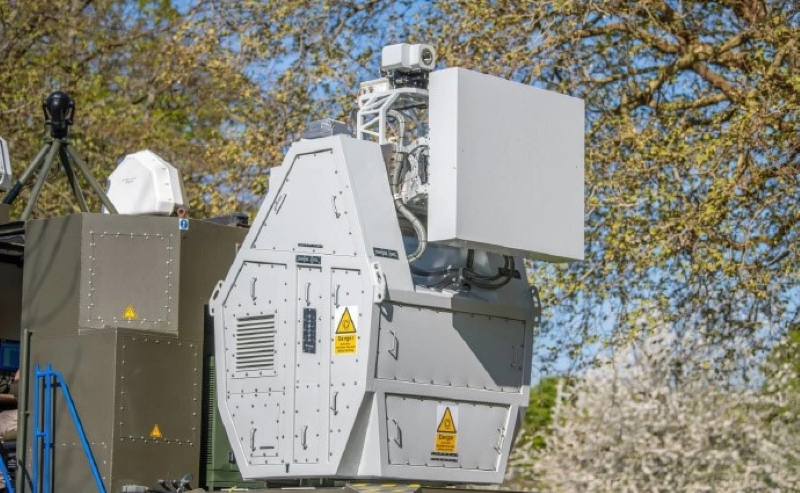Recently, the UK Ministry of Defense announced that its new anti-drone laser weapon passed a key test. The laser weapon successfully shot down a drone in the air at a test center in mid-Wales, marking an important step for the UK in laser weapon technology. This technology not only demonstrates the high precision and real-time tracking capabilities of laser weapons, but also brings a new way of fighting to the future battlefield, making it an important tool for countering drones.
The weapon can use radio waves to shoot down drone swarms. This new vehicle-mounted radio frequency directed energy weapon (RFDEW) can effectively destroy swarms of drones at a distance of up to one kilometer, and the cost of shooting down a single drone is only about 10 pence. The UK Ministry of Defense jokingly said that the cost of RFDEW to shoot down a group of drones is “lower than a pack of mince pies.”
Advances in UK Anti-drone Laser Weapons
Previously, the British Army also successfully tested a Wolfhound high-energy laser weapon system (HELWS), a drone interception weapon that uses high-energy lasers to detect and track enemy drones, focusing the laser beam on them until they are destroyed. While the laser-based HELWS system demonstrated 100% effectiveness in testing, its description also raises questions about its ability to counter drone swarms. What if a large-scale drone swarm needs to be dealt with? The successful test of RFDEW, with its completely different drone countermeasure technology, is expected to solve these practical problems.
The UK Ministry of Defense explained that RFDEW uses high-frequency waves to interfere with or destroy key electronic components inside equipment such as drones, causing them to malfunction or fall. RFDEW can effectively counter land-based or sea-based drones. Like HELWS, RFDEW was also tested at a range in western Wales.
The core advantage of laser weapons lies in their almost unlimited supply of “ammunition”. In traditional weapon systems, each shell is a costly consumable, while the implementation of laser weapons means a sustained strike capability based on electricity. The UK Ministry of Defense said that the weapon can accurately lock on to the target and quickly fire lasers through advanced sensors and tracking systems, successfully shooting down multiple drones in the test. The implementation of this technology is definitely a revolution in modern warfare technology and is expected to completely change the situation of anti-drone operations.
In addition to anti-drone capabilities, the cost-effectiveness of laser weapons is also an important reason why they are valued. The high military expenditure has prompted the armies of various countries to look for more effective weapon systems, and laser weapons reduce the cost of each use by electronic means, while avoiding the logistics and storage problems of traditional weapons. With the popularization of drone technology, the number of drones in combat environments will continue to increase, and the emergence of laser weapons can provide more innovative solutions for the military. The cost of shooting down a single drone by RFDEW is very low. At the same time, it is also economical in terms of labor costs. The British Ministry of Defense said that the system is highly automated and only requires one operator. In addition, the system is flexible in deployment and can be easily installed on military vehicles.

Advantages of Laser Weapons
Laser weapons are directed energy weapons that use directed laser beams to directly damage or disable targets. The core of the laser weapon system is a high-energy laser, which is also equipped with adaptive optical systems, radar or television guidance systems, capture and tracking aiming systems, beam control and launch systems, etc. Compared with traditional weapons such as bullets and missiles, laser weapons have obvious advantages. Lasers can propagate at a speed of 300,000 km/s, and the time required from launch to hitting the target is almost negligible, which has an unparalleled speed advantage. In the battlefield where “speed is combat effectiveness”, laser weapons can quickly lock and destroy targets, which is very suitable for intercepting high-speed or high-mobility targets, helping commanders gain the upper hand on the battlefield.
When using traditional weapons, it is necessary to accurately calculate the impact of gravity, wind speed, air density, earth rotation and other factors on the trajectory, while the attack of laser weapons is linear and is not affected by the above factors. It can also maintain high accuracy when shooting at long distances; at the same time, through advanced tracking systems and measurement technologies, laser weapons can quickly and accurately lock targets and strike, reduce accidental injuries and killings, and greatly improve the accuracy of the attack.
The British Ministry of Defense Actively Promotes International Cooperation And Exchanges
In addition to technological breakthroughs and innovations, the British Ministry of Defense is also actively promoting international cooperation and exchanges in drone defense technology. They have signed technical cooperation agreements with many countries to jointly carry out research and development of drone defense technology. This model of international cooperation not only helps countries to jointly improve drone defense capabilities, but also promotes the exchange and progress of global military technology. Today, as drone defense technology is increasingly becoming the focus of international military competition, this series of measures by the UK undoubtedly has far-reaching significance and impact. They not only demonstrate the UK’s leading position and innovation capabilities in the field of drone defense technology, but also provide new ideas and directions for the development and progress of global military technology.
Even though it is still regarded as the latest technology, the research and development of laser weapons in other countries is also continuing to advance. For example, South Korea recently announced the start of large-scale production of laser weapons. This trend not only shows the importance of laser weapons worldwide, but also emphasizes the urgency of countries to improve their comprehensive combat capabilities when facing drone threats.
Looking to the future, with the continuous advancement of technology, laser weapons are expected to play an important role in both military and civilian fields. In addition to military applications, laser weapons may also find their place in areas such as civil aviation safety, which is a prospect worth looking forward to.












